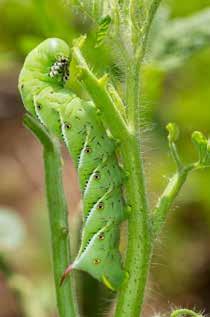
5 minute read
Ask the Experts
TIMELY GARDEN CLEANUP PROTECTS OVERWINTERING INSECTS
Question: I read that I can help protect any overwintering beneficial insects and pollinators in my garden by modifying my spring cleanup. Determining when to do the cleanup is confusing. The sources I read vary and I have a hard time finding something for the KC area. What are your recommendations?
Answer: Delaying garden clean up provides additional time for any overwintering stages of beneficial insects to develop and exit the debris. But it is difficult to know when it is safe. My take is to wait until there is about a week of high temperatures in the 50s. This should give them enough time to emerge from their winter slumber.
Besides waiting for Mother Nature to do her thing, here are a few other tips. Restrain yourself from finely chopping and stuffing the debris into a sack for recycling. Instead, remove the dead waste and pile it loosely in a hidden corner of the garden, allowing it to naturally compost. Then you know for sure all is clear and even provided more nesting material for the summer. The second tip is to chop the debris into 4 to 6 inches pieces and let drop back in and around the plants. This allows for late-maturing insects to develop, reduces waste, and becomes a natural mulch.
Personally, I like to use a combination of these options. I pull dead material off the plants and leave it in the garden for mulch. Hope these hints help you help our pollinators.
TOMATO CAGES
Question: I am tired of the cheap tomato cages that are either not tall enough or strong enough to support a healthy plant. Can you tell me what you would recommend?
Answer: I know what you mean. Those wimpy wire cages are not worth dragging home for tomatoes. My recommendation, and what I use, is a cage constructed from concrete reinforcing wire. Concrete wire is usually 5 feet high, comes in 100-foot rolls with 6-inch openings, and available for purchase at hardware stores. Lengths of 6 to 7 feet cut and formed into a round cage make a 20 to 24 inches in diameter cage that works great.
These cages may need a stake to ensure they stay upright on windy days. The plus side is they will last for years, and the 6-inch openings makes harvesting easy. The downside is a roll of wire makes numerous cages, probably more than you may need. The adult stage is a night flying sphinx moth and is a beneficial pollinator.
Here is how the two can coexist. Plant a fast-growing rangy cherry tomato and let it be the food source for the larvae. As they develop during the summer, simply pick them off the “good” tomato plants
and place them on your sacrificial cherry tomato. This protects your plants for harvest and allows the hornworm to have a food source to develop. It is a win-win. What more could you ask for!

Tomato plants need sturdy cage. Tomato hornworm caterpillar.
PLANT A FOOD SOURCE SPECIFICIALLY FOR TOMATO HORNWORM
Question: As I learn more about pollinators, I realize the dreaded tomato hornworm that devours the foliage is also a good pollinator. How can the two exist together? How can I keep them from eating my plants while also allowing them to develop and pollinate other plants?
Answer: The larval stage of the tomato hornworm, large and green, can strip the foliage off a tomato plant, significantly reducing yields. NEED CLARITY FOR USING ROUNDUP
Question: I know Roundup is controversial, but I like to use the product to get rid of pesky weeds. Do you have any guidelines for how long to wait between applying and replanting? When I search the internet, I find a lot of information but no clear answer to my question.
Answer: The best solution to this question is found on the label for the glyphosate or Roundup product. Of course, you will need to retrieve your magnifying lens, a bright light and tip your bifocals just right to read it. Can they make the print any smaller or put more creases in the paper?
A simple answer is this. Roundup is not active once it dries. It does take time for the chemical to translocate through the plant for effective elimination. My take is give it a few days before you start working around the plants. Roundup does not have soil action affecting the germination or establishment of the plant. If you plan to till the soil, then I am not sure you need to apply. Whenever you disturb the soil, more than likely, weeds will sprout, which means you could need another application. I think Roundup is best used in locations where the soil will not be tilled. According to a Roundup website, they say wait one day for ornamentals and three days for lawns, vegetables and herbs. Please read the information on the label for your situation. It is your best and only source.
HOW TO KNOW IF MY PLANTS SURVIVED
Question: I am concerned some of my plants didn’t survive the winter cold. How can I tell if they are alive or dead?
Answer: You are not alone in wondering about the health of your plants after the February arctic blast. Here is the simple way to tell. Wait and see. As spring arrives, the plant will tell you. Plants damaged will be slow to emerge, or growth may come from below ground. It may be well into May until a damaged plant shows signs of life.
You can also scratch a branch. If the cambium layer is green and moist, the plant is alive. If it is dry and brown, well, that is not a good sign. Lastly, get a sharp knife and cut through some of the bigger buds. The bud inside should be green and showing signs of life. A brown bud is not alive.
My advice is to be patient and wait before making any pruning cuts. Nature will let us know if or how much damage was caused by the extreme winter temperatures.
DENNIS PATTON Horticulture Agent
Dennis Patton is the horticulture agent for Johnson County K-State Research and Extension. For free information fact sheets, visit www.johnson.ksu.edu, or call the Extension office at 913-715-7000.


This Summer, MAKE YOUR BACKYARD DREAMS A REALITY
At KC Landscapes, we have mastered the art of blurring the lines between inside and outside — and our poolscapes are no exception.
Our experts bring together the best design and construction methods to realize your vision, providing your family a place you can enjoy in the privacy of your own backyard - for years to come.
Email info@kclandscapes.com for more information or visit our website at the link below.










